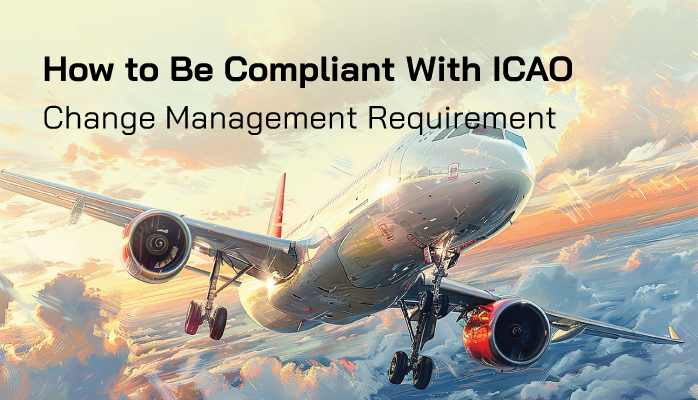What Is Change Management

Management of change in aviation SMS is a formal process for facilitating changes in safety programs. Usually, this process is instigated when required changes are going to affect higher-level, systems in the SMS. Smaller changes are handled with corrective actions.
The basic tenants of management of change in aviation SMS are:
- Airlines, airports, and other aviation service providers establish a formal, repeatable process for change;
- All relevant stakeholders are involved in the change;
- All data and safety cases related to the change need to be thoroughly analyzed and assessed; and
- The change is implemented through many smaller changes through the use of corrective preventative actions.
A common strategy for change is to have one manager facilitate the change, and a responsible manager review and approve each stage of the change process as it’s completed.
Here is how to be compliant with ICAO change management requirements in aviation SMS.
5.3.74 Have Good Reason for Change
ICAO notes that aviation service “providers may experience change for reasons.” Some of the reasons they point out are:
- Organizational expansion or contraction;
- Changes to internal systems that support services; and
- Changes in the operational environment.
There may be other reasons you experience change as well.
What this requirement subtly hints at is that it’s a good practice to:
- Have a good reason to use your change management process for change;
- Document, in clear terms, the reason that instigates change management process; and
- Document goals for change.
This practice allows auditors to quickly understand why you are performing changes and whether or not actual change implementation satisfied your goals.
5.3.75 Identify New Hazards/Risks Where Applicable

ICAO notes the obvious fact that changes may affect the appropriateness or effectiveness of existing mitigation strategies. This is because of the addition of new information, such as:
- New hazards;
- New risks; or
- Risk controls losing effectiveness in light of change.
You want this information to be captured by performing a “safety review.” A safety review is simply a comprehensive analysis of the affected system through the lens of implementing the change. What will your operations and environment look like after the change is implemented? Are there new hazards?
You should identify all new additional information you identify during your safety review.
5.3.76(a) Change Management Process Includes Criticality Assessments
During your change management process, you need to account for (i.e., document), “criticality” elements of the change. Criticality includes:
- Systems affected by change;
- Equipment affected by change;
- Activities affected by change; and
- Other mission-critical operations affected by the change.
Any elements affected by the change should be risk assessed. If they are not within an acceptable level of safety given existing risk controls, corrective actions will need to be created and implemented. These CPAs should be documented.
Related Management of Change Articles
- 4 Essential Tips for Management of Change in Aviation SMS
- What Are Best Practices for Change Management in Aviation SMS
- What Is Change Management in Your Aviation SMS?
5.3.76(b) Change Management Process Considers Stability of Systems
Most often, change management documentation only includes “stable” operations. However, in many cases, it is extremely useful to consider how an implemented change will be affected by unplanned changes.
Unplanned changes can be things like:
- Economic cycles;
- Labor unrest;
- Regulatory changes (how could compliance change affect this change?); or
- Political changes.
Ideally, your implemented change should account for unplanned changes to at least some degree. You can account for this by documenting which kinds of unplanned changes make your implemented change vulnerable, and how you might address it.
5.3.76(c) Change Management Process Accounts for Past Performance
Your change management needs to take into account past performance. Why?
- Poor past performance makes change management harder and needs to be implemented much more carefully (such as with a much greater degree of planning and guidance);
- Good past performance allows management to streamline documentation and planning efforts a bit because it can plan changes, but also rely on employees to fulfill required work.
Accounting for past performance could involve having a summary section describing how past performance affects how you will document and plan the current change management operation.
5.3.77 Changes Include Incremental Change Process
Finally, your change management operations will often take place over a long period of time. As you implement your change, chances are your initial description of changes will need updating to reflect such new information.
Make sure you update as you go along so that your documentation of your change always reflects the actual change.
Last updated in December 2024.





